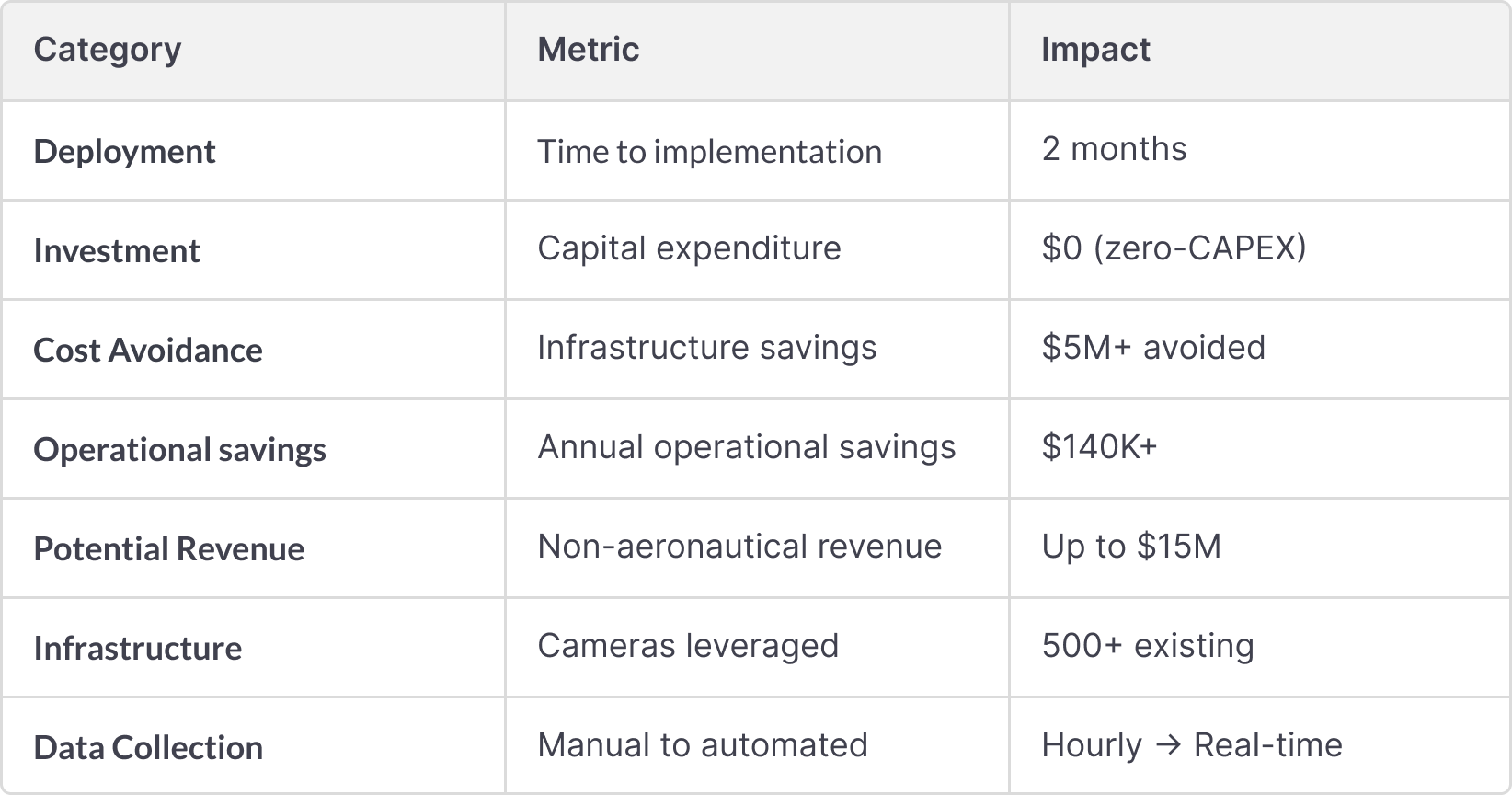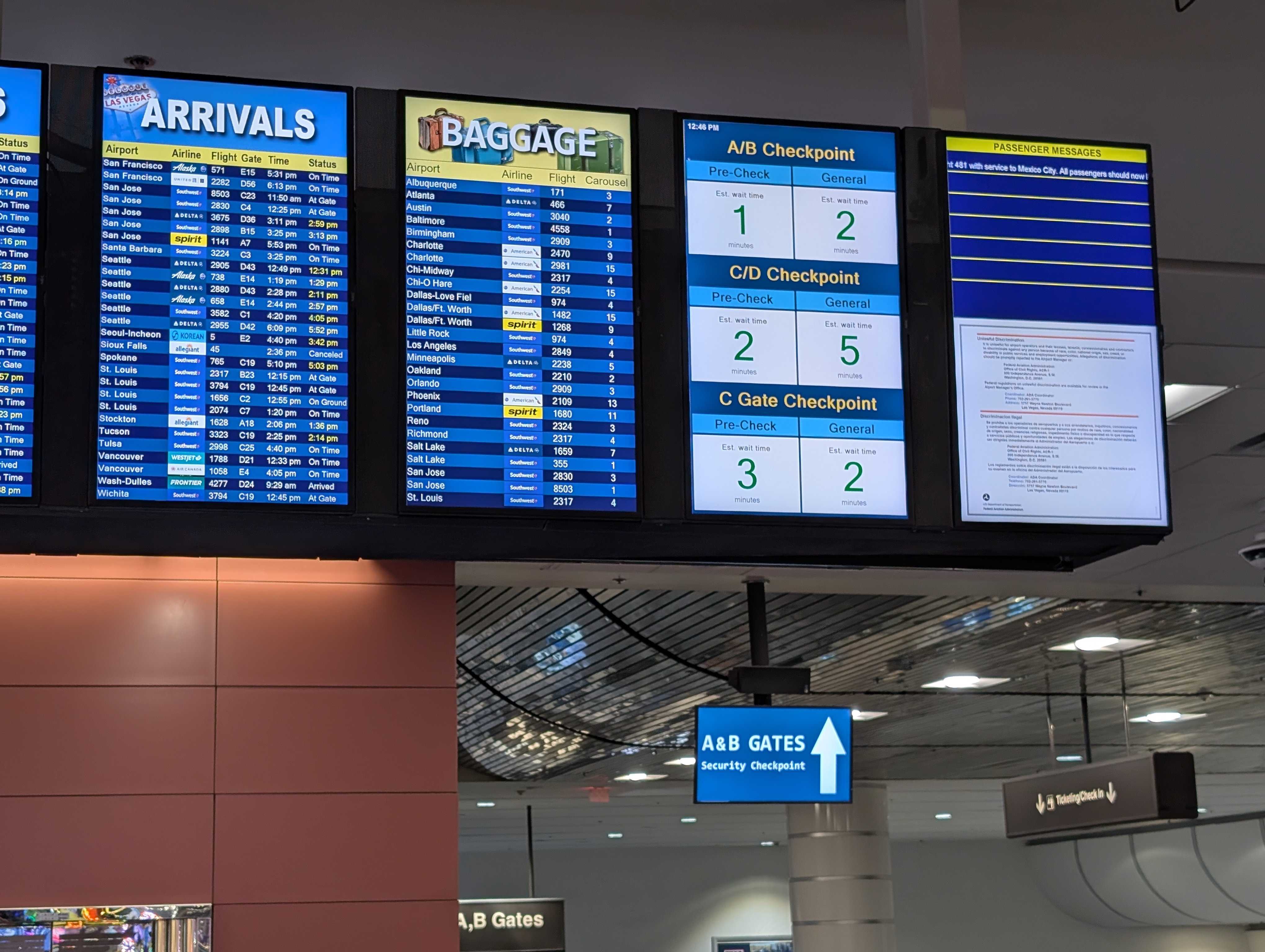Harry Reid International Airport (LAS) transformed passenger processing and operational efficiency by deploying an AI-powered PhysicalIntelligence platform from Zensors. Leveraging over 500 existing security cameras, the airport gained real-time visibility into passenger flow across terminals—eliminating the need for costly new infrastructure. Deployed in two months with zero capital expenditure, the solution shifted operations from manual, hourly data collection to real-time situational awareness. The platform powers airport operations, security checkpoint personnel, and airline partners to proactively manage queues, optimize staffing, and significantly enhance the passenger experience through data-driven decision making.
.png)
⚠️ The Challenge: Moving From Anecdotal to Data-Driven Operations
LAS faced a fundamental challenge: Improving the airport experience required better information for all stakeholders including leisure and business travelers, airport operational teams, and airlines. The airport needed real-time information, trend analysis, and predictive capabilities to make informed decisions.
The existing approach was inadequate:
• Manual data collection: Staff collected checkpoint data hourly for future reporting, taking team members away from other critical activities
• Reactive decision-making: Without real-time visibility, managers relied on phone calls to understand checkpoint status, piecing together fragmented information after problems emerged
• No passenger guidance: Travelers had no wait time information, creating anxiety about missing flights and preventing them from choosing the fastest checkpoint
• Limited operational insight: Staff lacked visibility into passenger throughput, queue variability, and checkpoint performance patterns
With major events like the Super Bowl, Formula 1, and Electric Daisy Carnival on the horizon, the airport needed to transition from anecdotal observations to real-time situational awareness for everyone.
✅ The Solution: Evaluation and Strategic Partnership
The airport evaluated multiple technology approaches including LiDAR, Bluetooth, proprietary sensors, and camera-based solutions. Zensors was selected based on:
• Proven capabilities to execute the complex deployment
• Deep understanding of airport operational needs and constraints
• Willingness to iterate through potential solutions during evaluation
• Comprehensive onboarding process from value assessment to full implementation
Implementation Approach
The deployment followed a strategic and collaborative process:
• Operational analysis: Studied checkpoint floor plans, passenger behavior patterns, and queue variability across different times and events
• Infrastructure mapping: Mapped existing camera locations to optimize coverage without new hardware
• Stakeholder engagement: Conducted interviews with airport operations, security personnel, airlines, and IT teams to understand requirements
• Security compliance: Completed cybersecurity reviews to ensure platform met airport security standards
• AI training: Ingested camera streams and trained AI models to accurately detect passenger flow and queue conditions
• System integration: Connected platform with flight information display systems for coordinated passenger guidance
• Application development: Built mobile and web interfaces for staff alerts and passenger wait time displays
• Staff training: Onboarded operational teams to use real-time data for proactive decision-making
• Community awareness: Prepared passengers for new wait time displays and guidance systems
Data Assurance and Integrity
The success at LAS relied heavily on data accuracy. AI-generated insights were regularly cross-referenced with manual observations to verify precision. The project team validated AI predictions against actual conditions, ensuring the models maintained accuracy across routine operations and peak events. This validation was crucial for implementation and adoption within daily operations.
The process spanned several weeks, encompassing specific scenarios including multiple queue tracking, overflow conditions, lane availability, and alternate queuing situations. Analyzing large amounts of data outside of the platform took time to interpret and produce the findings. Each iteration consistently yielded high accuracy, enabling operational teams to build confidence in the system.
This approach proved essential to the adoption stage. Automated systems processed data from hundreds of cameras instantly, while manual verification ensured data accuracy and system integrity. This dual validation gave operational teams the confidence to act decisively—predicting queue size, adjusting staffing, and providing accurate information to passengers—all based on reliable data.
Technology Stack
The solution leverages best-in-class technologies with the Zensors Physical AI model that is running on NVIDIA-accelerated computing for real-time AI processing and the Zensors Hologram Platform on AWS cloud infrastructure for easy scaling out and reliable operations.
The Impact

Manual Reports to Real-Time Intelligence
The transformation delivered measurable operational improvements:
• Eliminated manual data collection: Hourly manual reporting that pulled team members from other activities replaced with continuous, automated real-time data
• Precise throughput measurement: Passenger flow can now be accurately measured and continually improved based on data-driven insights
• Predictive queue management: System predicts queue overflow conditions, enabling proactive response to safely monitor and adjust passenger flow
• Increased team productivity: Staff use the system instead of writing manual reports, freeing time for passenger service
Stakeholder Alignment and Satisfaction
All stakeholders are invested in the platform. Feedback from passengers and airlines has been positive, reflecting the value of transparent, real-time information sharing across the airport ecosystem.

"What may appear to be a simple screen update is actually powered by sophisticated AI and machine learning models, working behind the scenes to deliver accurate, real-time insights to our guests. And it's only going to get better as we continue to expand the system."
— Rishma M. Khimji, Chief Information Technology Officer
.jpeg)
"During chaotic times, I used to rely on calling staff to understand what was happening at the checkpoints. The Zensors AI solution completely changed that! Now, I can just pull out my phone and instantly see the real-time status across all terminals, no need to call people for updates. Plus, when an issue surfaces, security operators and my team are instantly notified with suggested actions to quickly remedy the problem."
— Scott Kley, Managing Director - Terminal Operations
Financial Benefits
• Over $5million in avoided capital costs: Traditional sensor solutions would have required $10,000+ per device for hardware, installation, cabling, and project management across 500+locations
• Operational savings of $140,000+ annually: Automated checkpoint monitoring eliminates dedicated manual observation, with conservative estimates of $35,000 savings per terminal checkpoint
• Potential $15 million annual revenue increase: Projections show that reducing queue time by just 3 minutes for 20% of passengers during peak periods could generate significant additional non-aeronautical revenue as travelers spend more time in concessions
Key Impact Summary

Lessons Learned and Best Practices
1. Leverage Existing Infrastructure
Most airports have significant investments in security surveillance systems. Rather than treating these as single-purpose assets, airports should explore how to extract additional value from existing cameras through AI-powered analytics. This approach avoids costly new infrastructure while delivering transformative capabilities.
2. Prioritize Easy Integration and Adoption
The technology proved easy to integrate with existing systems and adopt across all team members. Success depends on selecting solutions that work within current infrastructure and workflows rather than requiring wholesale operational changes. User-friendly interfaces ensure broad adoption from day one.
3. Build Operational Intelligence
The platform provides better understanding of how the airport operates in day-to-day conditions. This operational intelligence helps teams manage everything from routine operations to peak demand periods—moving from reactive crisis management to proactive planning based on data and predictive insights.
4. Manage Peak Demand Proactively
The system helps transition peak event management from anxious anticipation to business-as-usual confidence. With predictive capabilities and early warning alerts, staff can prepare for surges before they create passenger frustration.
Future Roadmap
The success at security checkpoints has established a foundation for airport-wide expansion. Potential areas for implementation include:
• Roadway and curbside management: Monitor vehicle congestion and passenger volume at pickup/drop-off areas
• Check-in counter optimization: Track queue lengths and processing times to improve airline counter operations
• Gate hold room capacity: Manage boarding area congestion and improve passenger flow
• Concession and restaurant insights: Provide retailers with foot traffic data to optimize staffing and inventory
With the success of the checkpoint implementation, expanding the system will provide an improved end-to-end passenger experience while establishing the standard for future airport modernization efforts—proving that practical use of this type of technology can deliver an enriched experience to our guests, our team members, and our community.
Conclusion
LAS demonstrates that transformative operational improvements do not require major infrastructure build outs. By leveraging existing security cameras with Zensors' AI-powered platform, the airport achieved rapid deployment, significant cost savings, and measurable improvements in passenger experience and operational efficiency. The success establishes a blueprint for airports seeking to modernize operations while maximizing return on existing investments.



